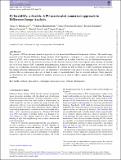Files in this item
PyTorchDIA : a flexible, GPU-accelerated numerical approach to Difference Image Analysis
Item metadata
| dc.contributor.author | Hitchcock, James A | |
| dc.contributor.author | Hundertmark, Markus | |
| dc.contributor.author | Foreman-Mackey, Daniel | |
| dc.contributor.author | Bachelet, Etienne | |
| dc.contributor.author | Dominik, Martin | |
| dc.contributor.author | Street, Rachel | |
| dc.contributor.author | Tsapras, Yiannis | |
| dc.date.accessioned | 2021-05-10T15:30:10Z | |
| dc.date.available | 2021-05-10T15:30:10Z | |
| dc.date.issued | 2021-07 | |
| dc.identifier | 274064742 | |
| dc.identifier | d69dda75-1fbc-4e39-8c61-1e9fe7561b4a | |
| dc.identifier | 000656139300032 | |
| dc.identifier | 85107899746 | |
| dc.identifier.citation | Hitchcock , J A , Hundertmark , M , Foreman-Mackey , D , Bachelet , E , Dominik , M , Street , R & Tsapras , Y 2021 , ' PyTorchDIA : a flexible, GPU-accelerated numerical approach to Difference Image Analysis ' , Monthly Notices of the Royal Astronomical Society , vol. 504 , no. 3 , pp. 3561–3579 . https://doi.org/10.1093/mnras/stab1114 | en |
| dc.identifier.issn | 0035-8711 | |
| dc.identifier.other | Jisc: ef9d9eafa2e345988c43becb2ddecacc | |
| dc.identifier.other | ORCID: /0000-0002-3202-0343/work/93514545 | |
| dc.identifier.uri | https://hdl.handle.net/10023/23149 | |
| dc.description | Funding: JAH gratefully acknowledges funding from the Science and Technology Facilities Council of the United Kingdom. | en |
| dc.description.abstract | We present a GPU-accelerated numerical approach for fast kernel and differential background solutions. The model image proposed in the Bramich (2008) difference image analysis algorithm is analogous to a very simple Convolutional Neural Network (CNN), with a single convolutional filter (i.e. the kernel) and an added scalar bias (i.e. the differential background). Here, we do not solve for the discrete pixel array in the classical, analytical linear least-squares sense. Instead, by making use of PyTorch tensors (GPU compatible multi-dimensional matrices) and associated deep learning tools, we solve for the kernel via an inherently massively parallel optimisation. By casting the Difference Image Analysis (DIA) problem as a GPU-accelerated optimisation which utilises automatic differentiation tools, our algorithm is both flexible to the choice of scalar objective function, and can perform DIA on astronomical data sets at least an order of magnitude faster than its classical analogue. More generally, we demonstrate that tools developed for machine learning can be used to address generic data analysis and modelling problems. | |
| dc.format.extent | 20 | |
| dc.format.extent | 6862540 | |
| dc.language.iso | eng | |
| dc.relation.ispartof | Monthly Notices of the Royal Astronomical Society | en |
| dc.subject | Methods: data analysis | en |
| dc.subject | Techniques: image processing | en |
| dc.subject | Software: development | en |
| dc.subject | QB Astronomy | en |
| dc.subject | QC Physics | en |
| dc.subject | DAS | en |
| dc.subject.lcc | QB | en |
| dc.subject.lcc | QC | en |
| dc.title | PyTorchDIA : a flexible, GPU-accelerated numerical approach to Difference Image Analysis | en |
| dc.type | Journal article | en |
| dc.contributor.institution | University of St Andrews. School of Physics and Astronomy | en |
| dc.contributor.institution | University of St Andrews. St Andrews Centre for Exoplanet Science | en |
| dc.identifier.doi | 10.1093/mnras/stab1114 | |
| dc.description.status | Peer reviewed | en |
| dc.identifier.url | https://github.com/jah1994/PyTorchDIA | en |
This item appears in the following Collection(s)
Items in the St Andrews Research Repository are protected by copyright, with all rights reserved, unless otherwise indicated.

